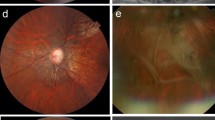Abstract
We have examined the electroretinographic responses, the psychophysically determined course of dark adaptation and/or the scotopic and photopic (static) perimetric profile of the uninjured eyes of 11 patients with unilateral intraocular foreign bodies. Most of the patients showed subnormal ERG amplitudes over a range of light intensities, and subnormal light sensitivity in isolated retinal areas. The data suggest that eyes not directly injured by a unilateral traumatic ocular episode may show visual defects.
Similar content being viewed by others
References
Abraham FA (1977) Enhanced ERG following monocular injury. Docum Ophthal Proc Ser 11:131–137
Auerbach E (1977) Tasks and goals of a clinically oriented vision research laboratory. Its role in research and its application to serve patients. In: Frontiers in Visual Science, eds: SJ Cool and EL Smith III. Berlin, Springer, p. 764–785
Auerbach E, Godel V and Rowe H (1969) An electrophysiological and psychophysical study of two forms of congenital night blindness. Invest Ophthal 8:332–345
Auerbach E and Kripke B (1974) Achromatopsia with amblyopia. II. A psychophysical study of 5 cases. Docum Ophthal 37:119–144
Brindley GS and Hamaski DI (1962) Evidence that the cats electroretinogram is not influenced by impulse passing along the optic nerve. J Physiol (London) 163:558–565
Cabello J and Stiles WS (1976) as cited in The Eye, ed: H Davson, vol. 2A. London, Academic Press, p. 81
Cowan WM and Powell TPS (1963) Centrifugal fibres in the avian visual system. Proc Roy Soc B 158:232–252
Duke-Elder S and Perkins ES (1966) Diseases of the uveal tract. In: System of Ophthalmology, ed: S Duke-Elder. St Louis, Mosby
Honrubia FM and Elliott JH (1968) Efferent innervation of the retina. I. Microscopic study of the human retina. Arch Ophthal 80:98–103
Honrubia FM and Elliott JH (1970) Efferent innervation of the retina. II. Morphologic study of the monkey retina. Invest Ophthal 9:971–976
Karpe G (1948) Early diagnosis of siderosis retinae by the use of electroretinography. Docum Ophthal 2:277
Knighton RW and Lewis ML (1979) Need for bilateral electroretinography in unilateral trauma. Ophthal Surg 10:64–65
Makous W, Teller D and Boothe R (1976) Binocular interaction in the dark. Vision Res 16:473–476
Nawratzki I, Auerbach E and Rowe H (1966) Amblyopia ex anopsia: the electrical response in retina and occipital cortex following photic stimulation of normal and amblyotic eyes. Amer J Ophthal 61:430–435
Niiranen M (1978) Perforating eye injuries: a comparative epidemiological prognostic and socio-economic study of patients treated in 1930–39 and 1950–59. Acta Ophthal Suppl 135
Paris J and Prestrude AM (1975) On the mechanisms of the interocular light adaptation effect. Vision Res 15:595–603
Sloan LL (1971) The Tubinger perimeter of Harms and Aulhorn. Arch Ophthal 86:612–622
Witkovsky P (1971) Synapses made by myelinated fibers running to teleost and elasmobranch retinas. J Comp Neurol 142:205–222
Author information
Authors and Affiliations
Rights and permissions
About this article
Cite this article
Kaitz, M., Perlman, I., Ovadia, N. et al. Visual defects in the uninjured eye of patients with unilateral eye injury. Doc Ophthalmol 53, 179–190 (1982). https://doi.org/10.1007/BF00142485
Issue Date:
DOI: https://doi.org/10.1007/BF00142485




